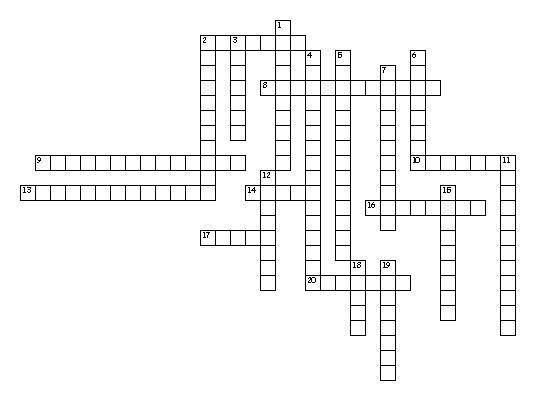The Industrial Revolution
Crossword: Sections 1 and 2 of Chapter 21 pp 588-599
Why
We Remember

Across
2. Money used to produce goods. (Capital)
8. Developed the air brake (590). (Westinghouse)
9. (2 words) Also called capitalism, it is the economic system where
businesses
are free to compete without government rules (pg 592).
(Free Enterprise)
10. These shipping costs were paid by railroads for using their company.
(Tarrifs)
13. Combining several companies into one large company. (Merger)
14. He developed a railway telegraph system (590). (Morse)
16. Customers demanded that the government do this to the railroads. (Regulate)
17. It is the distance between rails (pg 590). (Gauge)
20. The __________ Antitrust Act of 1890 declared "any combination...
in restraint of trade"
illegal. (Sherman)
Down
1. He was the master of consolidating railroads. (Vanderbilt)
2. A type of business that raises money by selling shares of stock to
investors. (Corporation)
3. Created a sleeping car for overnight travel (590). (Pullman)
4. (2 words) Rivers, forests, coal, iron ore, and fossil fuels count as
these. (pg 588) (Natural Resources)
5. (2 words) It was the first store that used a catalogue to allow shopping by
mail. (pp. 589-590). (Montgomery Ward)
6. His process reduced the cost of making steel. (pg. 594) (Bessemer)
7. He wanted to control all steps of oil production (pg 589). (Rockefeller)
11. Investors who own part of the business and who elect boards of
directors. (Stockholders)
12. Interstate ______________ means trade between states. (Commerce)
15. These made up the driving force behind the industrial revolution. (Railroads)
18. A business combination where a board of managers controlled member
corporations. (Trust)
19. He controlled the steel industry through consolidation. (Carnegie)
George Cassutto's Cyberlearning
World
[Lesson Plan of the
Day]
[Cassutto
Memorial] [About
the Author] [Search]
[Civics
Lesson Plans]
